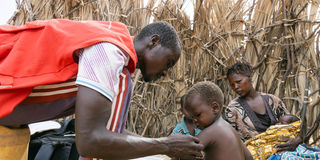Foot doctor who treks miles in scorching heat to save children’s lives

Charles Ekale, a Community Health Promoter in Turkana, attending to a child.
What you need to know:
- CHPs serve 100 households spread over a vast area and cover these distances on foot, especially in the arid and semi-arid counties where health facilities are few and far between.
In the rocky plains of Turkana County where roads are few and health facilities even fewer, a child’s life can depend on a single person.
That person is Charles Ekale – a Community Health Promoter (CHP).
Before dawn breaks, Charles tightens the straps of his medical kit—a frayed backpack holding the fragile line between life and loss—and begins his 25-kilometre trek across an arid terrain to save children’s lives. On other days, he walks to his makeshift “clinic” under a tree.
On the first day we meet Charles, he has set up a makeshift clinic under the shade of a large tree outside his home.
A weighing scale hangs from a tree branch. Charles opens his box of ‘simple tools’, checks his equipment and gathers his notebooks for record keeping.
He works at the clinic twice a week. On some days, there is a queue of people waiting to see him. But today, there is just one family with their 18-month-old baby, who Charles has been treating for malnutrition.
This makeshift clinic serves locals who brave the challenging terrain, long distances, and scorching sun to bring their children to see the “doctor.”
Although Charles lacks formal medical qualifications, his training by Save the Children in basic healthcare for common childhood illnesses and malnutrition and his unwavering dedication has earned him this respected title within the village.
Lomanat, a mother of six, has brought Baby Ereng to see Charles.
As we meet the family, Lomanat narrates how drought wiped out the only livestock her family had, forcing her to invest in a charcoal-burning business to feed her family. However, the business was not profitable as she had no means of transport to reach potential buyers.
“This is why my baby got sick; we didn’t have enough food. Because I had been trained on how to use the Family MUAC (Mid-Upper Arm Circumference ) tape — a simple, colour-coded tool used to quickly assess a child’s nutritional status by measuring their arm circumference — in a previous outreach, I measured Ereng, and I knew she was in bad shape. This is when I brought her to Charles” adds Lomanat
On their first visit, Charles screened Ereng and found that her upper arm circumference fell on the yellow part of the measuring tape. This meant that she had moderate acute malnutrition. With this diagnosis, Charles put her on Plumpynut – a fortified peanut butter paste packed with all the vitamins, minerals and calories for treating acute malnutrition in children. He told Lomanat to bring her back after two weeks.
Charles has been treating Ereng for more than two months. “Ereng has been in the yellow MUAC zone until recently. In the last two weeks, her MUAC indicated green, which means healthy weight. Upon screening her today, I have found that her MUAC lies in the green part of the band, and I have crossed her out of the register and discharged her from the programme. She came in weighing 7.2kg and has left at 9.6kg,” explains Charles.
A “Family MUAC tape” is a simple, colour-coded tape used by mothers, caregivers, and other family members to screen children for acute malnutrition by measuring their mid-upper arm circumference. It is mostly used among communities who live far away from health facilities.
According to the guidelines, once a child falls in a green MUAC zone twice, they are discharged from the programme.
“That’s the reason I have crossed lines in my book,” says Charles.
The joy on the faces of Ereng’s family is palpable.
“The doctor gave her chocolate-fortified peanut paste. Since then, she has started gaining weight, until I saw her come alive again” says Lomanat with a wide grin on her face.
The next day, we accompany Charles on a 27-kilometre journey to visit Selina, a new mother whose son, Daudi, is feverish and breathing rapidly. The trip takes hours—partly by a rugged 4x4, the rest on foot across dried riverbeds and thorn-scattered paths.
When we arrive, Charles quickly diagnoses Daudi with malaria using a rapid test kit, administers treatment, and logs the case on his Ministry of Health e-CHIS portal—a digital system helping track patients in remote areas.
He adds written notes in Selina’s government-issued mother and baby book and refers Baby Kevina, Selina’s other child, to the nearest clinic.
Selina knows that Charles is her best hope for keeping her children healthy. We learn that she had spent hours travelling to Charles’ village the previous day with Baby Daudi just nine days after she had given birth.
Like many residents in the region, this family has been badly affected by the recent drought, made worse by climate change. Most of Selina’s animals died, leaving her with little options for food or income.
The increasingly frequent droughts caused by climate change are making common, preventable diseases even more deadly for children.
CHPs like Charles, and their supporting mentors, are reaching children most at risk, but they cannot do this alone.
Save the Children has been working with other partners to train community health promoters in basic healthcare for common childhood illnesses and the electronic Community Health Information System.
CHPs serve 100 households spread over a vast area and cover these distances on foot, especially in the arid and semi-arid counties where health facilities are few and far between.
Charles mentions that sometimes it can take him over four hours on foot to get to the next household.
“If I had a motorbike, it would be so much easier to visit the households and immediately get refills from the nearest health facility,” he says.


